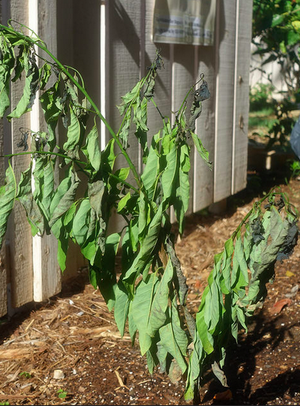
Wilting refers to the process by which plants shut down water loss when the temperature increases. In many plants, when the temperature rises above 21ºC, the stomata (the pores in leaves) shut down to preserve water and prevent further loss. When the stomata close, the usual process of transpiration (the water flowing from the root, up the stem and into the leaves) stops. This causes many of the usual processes in the plant to slow down and the plant's non-woody parts will wilt.
The wilting may be temporary, easily remedied in the cool of the evening. Or, it may be prolonged, as in the case of a drought and a continued lack of water. If the wilting is permanent, the plant will usually die.
Other causes of wilting[edit | edit source]
There are some other reasons why a plant may wilt, other than lack of water. These include:
- A high level of salinity
- The presence of bacteria, fungi or bugs interrupting normal plant processes
- Waterlogged soil (ironically, too much water can prevent the transportation of oxygen, so the plant can't use the water)
- Very low temperatures.